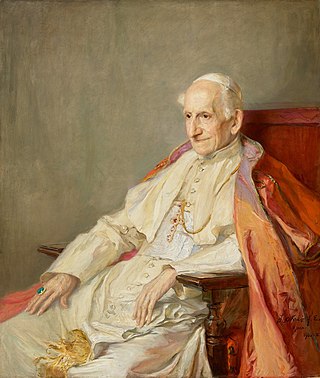Unitatis redintegratio is the Second Vatican Council's decree on ecumenism. It was passed by a vote of 2,137 to 11 of the bishops assembled at the Council, and was promulgated by Pope Paul VI on 21 November 1964.
Dignitatis humanae is the Second Vatican Council's Declaration on Religious Freedom. In the context of the council's stated intention "to develop the doctrine of recent popes on the inviolable rights of the human person and the constitutional order of society", Dignitatis humanae spells out the church's support for the protection of religious liberty. It set the ground rules by which the church would relate to secular states.
An encyclical was originally a circular letter sent to all the churches of a particular area in the ancient Roman Church. At that time, the word could be used for a letter sent out by any bishop. The word comes from the Late Latin encyclios. The term is now primarily associated with papal encyclicals.

The magisterium of the Catholic Church is the church's authority or office to give authentic interpretation of the word of God, "whether in its written form or in the form of Tradition". According to the 1992 Catechism of the Catholic Church, the task of interpretation is vested uniquely in the Pope and the bishops, though the concept has a complex history of development. Scripture and Tradition "make up a single sacred deposit of the Word of God, which is entrusted to the Church", and the magisterium is not independent of this, since "all that it proposes for belief as being divinely revealed is derived from this single deposit of faith."
Modernism in the Catholic Church describes attempts to reconcile Catholicism with modern culture, specifically an understanding of the Bible and Sacred Tradition in light of the historical-critical method and new philosophical and political developments of the late 19th and early 20th centuries.
Catholic social teaching (CST) is an area of Catholic doctrine which is concerned with human dignity and the common good in society. It addresses oppression, the role of the state, subsidiarity, social organization, social justice, and wealth distribution. CST's foundations are considered to have been laid by Pope Leo XIII's 1891 encyclical, Rerum novarum, which advocated distributism. Its roots can be traced to Catholic theologians such as Thomas Aquinas and Augustine of Hippo. CST is also derived from the Bible and cultures of the ancient Near East.

Providentissimus Deus, "On the Study of Holy Scripture", was an encyclical letter issued by Pope Leo XIII on 18 November 1893. In it, he reviewed the history of Bible study from the time of the Church Fathers to the present, spoke against the errors of the Rationalists and "higher critics", and outlined principles of scripture study and guidelines for how scripture was to be taught in seminaries. He also addressed the issues of apparent contradictions between the Bible and physical science, or between one part of scripture and another, and how such apparent contradictions can be resolved.
Mortalium animos is a papal encyclical promulgated in 1928 by Pope Pius XI on the subject of religious unity, condemning certain presumptions of the early ecumenical movement and confirming that the unique Church founded by Jesus Christ is the Catholic Church.
Ut unum sint is an encyclical on ecumenism by Pope John Paul II of 25 May 1995. It was one of 14 encyclicals he issued, and Cardinal Georges Cottier, Theologian Emeritus of the Pontifical Household, was influential in its drafting.
Apostolicae curae is the title of an apostolic letter, issued in 1896 by Pope Leo XIII, declaring all Anglican ordinations to be "absolutely null and utterly void". The Anglican Communion made no official reply, but the archbishops of Canterbury and York of the Church of England published a response known by its Latin title Saepius officio in 1897.
Aeterni Patris was an encyclical issued by Pope Leo XIII in August 1879. It was subtitled "On the Restoration of Christian Philosophy in Catholic Schools in the Spirit of the Angelic Doctor, St. Thomas Aquinas". The aim of the encyclical was to advance the revival of Scholastic philosophy.

Pastor aeternus was issued by the First Vatican Council, July 18, 1870. The document defines four doctrines of the Catholic faith: the apostolic primacy conferred on Peter, the perpetuity of the Petrine Primacy in the Roman pontiffs, the definition of the papal primacy as a papal supremacy, and Papal infallibility – infallible teaching authority (magisterium) of the Pope.

The theology of Pope Pius XII is reflected in his forty-one encyclicals, as well as speeches and nearly 1000 messages, during his almost 20-year pontificate. The encyclicals Mystici corporis and Mediator Dei advanced the understanding of membership and participation in the Catholic Church. The encyclical Divino afflante Spiritu began opening the door to historical-critical biblical studies. But his magisterium was far larger and is difficult to summarize. In numerous speeches Catholic teaching is related to various aspects of life, education, medicine, politics, war and peace, the life of saints, Mary, the mother of God, things eternal and temporal.
Aeterna Dei sapientia was the sixth encyclical made by Pope John XXIII, and was issued on 11 November 1961. It commemorates the fifteenth centennial of the death of Pope Leo I, also known as Leo the Great and a Doctor of the Church. It calls for Christian unity. It calls for Christendom to unite against external movements such as communism and secularism.

A dogma of the Catholic Church is defined as "a truth revealed by God, which the magisterium of the Church declared as binding". The Catechism of the Catholic Church states:
The Church's Magisterium asserts that it exercises the authority it holds from Christ to the fullest extent when it defines dogmas, that is, when it proposes, in a form obliging Catholics to an irrevocable adherence of faith, truths contained in divine Revelation or also when it proposes, in a definitive way, truths having a necessary connection with these.
The term dogmatic fact is employed in the teaching of the Catholic Church, to mean any fact connected with a dogma, wherein the application of the dogma is itself what constitutes, or more accurately canonizes, the fact.
The Roman Catholic Church in the 20th century entered into a period of renewal, responding to the challenge of increasing secularization of Western society and persecution resulting from great social unrest and revolutions in several countries. A major event in the period was the Second Vatican Council, which took place between 1962 and 1965. The church instituted reforms, especially in the 1970s after the conclusion of the Council, to modernize practices and positions. On taking office part way through the Council, Pope Paul VI referred to "an impatient struggle for renewal".

The theology of Pope Leo XIII was influenced by the ecclesial teachings of the First Vatican Council (1869-1870), which had ended only eight years before his election in 1878. Leo issued some 46 apostolic letters and encyclicals dealing with central issues in the areas of marriage and family and state and society.
The Eastern Orthodox Church is opposed to the Roman Catholic doctrine of papal supremacy. While not denying that primacy does exist for the Bishop of Rome, Eastern Orthodox Christians argue that the tradition of Rome's primacy in the early Church was not equivalent to the current doctrine of supremacy.






